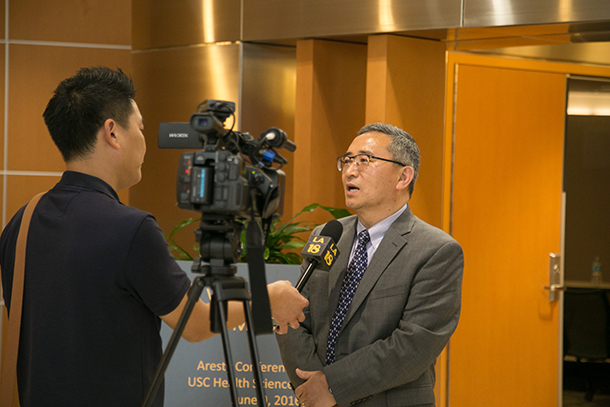Scientists and public officials warned residents of health risks and provided mosquito-abatement tips during the Zika Virus Awareness Symposium, held June 9 at the Aresty Auditorium on the Health Sciences Campus.
Lecture topics ranged from the control, diagnosis and treatment of the Zika virus and how this epidemic may affect the Los Angeles area as well as the entire world, to an in-depth look at the way Zika acts in the body to cause hydrocephaly in babies and the neurological disorder Guillain-Barré syndrome, provided by speakers from the Keck School of Medicine of USC, as well as from UCLA and the Los Angeles County and state departments of public health.

Attendees listen to speakers during the Zika Virus Awareness Symposium, held June 9 at Aresty Auditorium on the Health Sciences Campus. (Photo/Ricardo Carrasco III)
Distinguished Professor Jae Jung, PhD, chair of the Department of Molecular Microbiology and Immunology and the director of the USC Institute for Emerging Pathogens and Immune Diseases at the Keck School, said that Los Angeles’ position as a travel hub in the United States is a cause for concern.
“Los Angeles is a gateway for germs,” he began, citing the vast numbers of people who enter Los Angeles through airports, ports, and by train and car. “There is an extensive potential for this infectious disease.”
However, he went on to say that local transmission of the virus might be less likely in Southern California. While detailing the occurrences of Zika in the United States, Jung pointed out that so far no cases in California have been locally transmitted.
Rachel Civen, MD, MPH, medical epidemiologist with the Los Angeles County Department of Public Health, spoke about the challenges with diagnosing Zika virus.
“Eighty percent of people with Zika are asymptomatic,” she said. “So most people don’t even have symptoms.”
Civen went on to say that even among the people who do have symptoms such as rash, fever, joint pain and conjunctivitis, the symptoms are mild and can last as little as one week. To further complicate matters, the symptoms of Zika are similar to dengue fever and Chikungunya, two other flaviviruses — a genus of viruses that also includes West Nile and yellow fever, which the genus is named for.
Several speakers reiterated the important steps everyone can take to reduce the spread of Zika virus in Southern California. These preventive measures include using screens on all open windows and wearing effective bug repellent when outside. Most importantly, experts recommend removing all standing water both inside and outdoors and scrubbing any containers that have held standing water in order to remove mosquito eggs left behind. It was also stated that since there is occurrence of sexually transmitted Zika, condoms should be used by at-risk people.
Other speakers at the event included Alexandre Bonnin, PhD, assistant professor of cell and neurobiology at the USC Zilkha Neurogenetic Institute; Genhong Cheng, PhD, professor of microbiology, immunology, and molecular genetics at UCLA; Kelly Middleton, MA, of the Greater Los Angeles County Vector Control District; Karin Nielsen, MD, MPH, professor of clinical pediatrics in the Division of Infectious Diseases at UCLA Children’s Hospital; Charsey Cole Porse, PhD, MPH, of the California Department of Health; and Los Angeles City Council Member Curren D. Price Jr., JD.
To see the recorded symposium in its entirety, go to http://keckmedia.usc.edu/Mediasite/Catalog/catalogs/Zika-Symposium.
— Amanda Busick

Jae Jung is interviewed during the Zika Virus Awareness Symposium, held June 9 at Aresty Auditorium on the Health Sciences Campus. (Photo/Ricardo Carrasco III)


